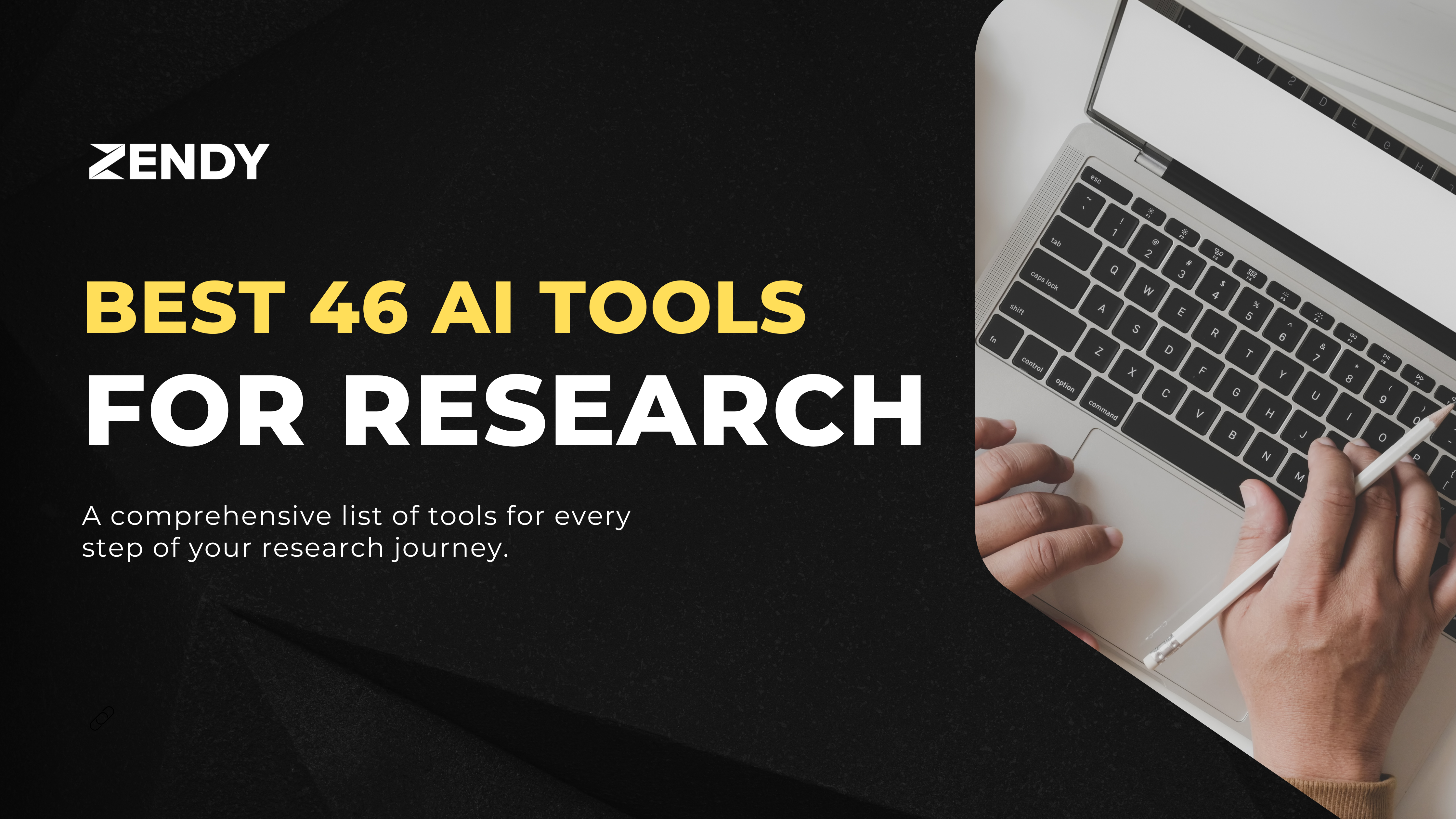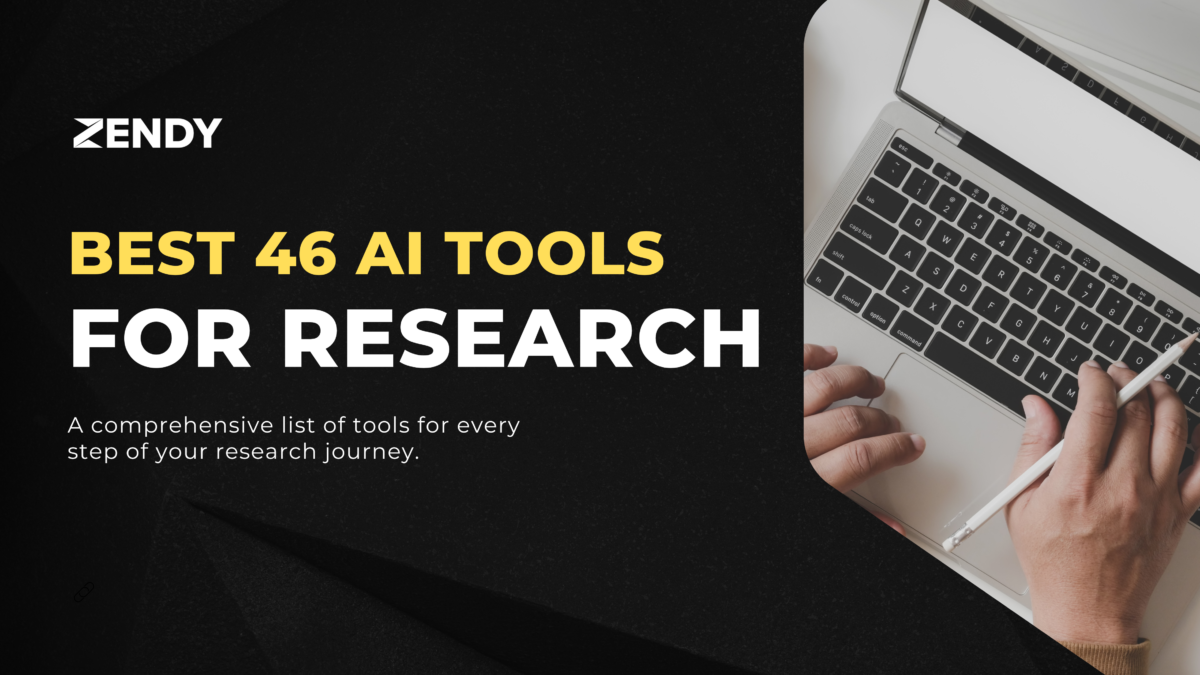
Five years ago, many believed Web 3.0 and a decentralised internet would reshape how we interact online. Instead, the real change came from artificial intelligence (AI). Quietly, it started showing up everywhere, from how we search to how we write and learn. In research, the impact of change is particularly evident. AI research tools have evolved beyond simple assistance. It’s now critical to how we study, gather information, and break down complex ideas.
In our recent 2025 AI survey by Zendy shows just how common AI tools for research have become: 73.6% of students and researchers say they use AI tools, with over half of them using AI tools for literature reviews and nearly as many using them for writing and editing.
Table of contents:
- AI Research Assistants for Students:
ZAIA, Elicit, Perplexity AI, Research Rabbit, Scite, ChatGPT, Connected Papers - AI-driven Literature Review Tools:
Zendy, Litmaps, ResearchPal, Sourcely, Consensus, R Discovery, Scinapse.io - AI-powered Writing Assistants:
PaperPal, Jenny.AI, Aithor, Wisio.app, Trinka AI, Grammarly - AI Tools for Data Analysis in Research:
Julius AI, Vizly, ChatGPT-4o, Polymer, Qlik - AI Paraphrasing Tools for Students:
Ref-n-write, SciSpace, MyEssayWriter.ai, Scribbr, Rewrite Guru - AI Productivity Tools for Researchers
Otter AI, Bit.ai, Todoist, Notion - AI Tools for Thesis Writing:
TheseAI, Gatsbi, Writefull, Thesify - AI Citation Management Tools:
Zotero, EndNote, Mendeley, RefWorks - AI Tools for Creating Research Presentations
Gamma, Presentations.AI, PopAI, AiPPT
AI Research Assistants for Students
Here are some of the favourite AI research assistants for students
- ZAIA: Zendy’s AI-powered research assistant, delivering precise, reference-backed academic insights and PDF analysis, saving time and enhancing focus
- Elicit: An AI research assistant that helps with literature reviews by summarising academic papers and refining research questions, but it’s limited to open-access sources and lacks full PDF upload support
- Perplexity AI: Search-based chatbot offering sourced answers from web and academic content, however, it’s good to keep in mind that perplexity was not designed for research support.
- Research Rabbit: Visual literature mapping tool for exploring academic papers and citation networks (limited by outdated MAG database).
- Scite: Citation analysis tool showing how papers reference each other, useful for evaluating credibility (paid, no full-paper summaries).
- ChatGPT (with research plugins): Versatile AI assistant for summarising, brainstorming, and drafting academic content (requires fact-checking).
- Connected Papers: Visual graph tool for discovering related research papers (limited journal coverage, no deep analysis).
AI-driven Literature Review Tools
Now you can save weeks, if not months, just by using one of these AI-driven literature review tools below:
- Zendy: AI-powered research platform offering access to millions of peer-reviewed papers with summarisation and citation tools (some features require payment).
- Litmaps: Visual citation mapping tool for tracing research connections and trends (no content analysis).
- ResearchPal: AI assistant for literature reviews and reference management, integrates with Zotero/Mendeley (paid plans for full features).
- Sourcely: Source-finding tool that suggests and cites relevant papers from 200M+ database (limited paywall access).
- Consensus: Search engine highlighting scientific consensus on topics using peer-reviewed sources (limited free version).
- R Discovery: Mobile app for personalised research paper discovery with audio/translation features (no deep analysis).
- Scinapse.io: Free citation-based academic search tool with AI-generated mini-reviews (limited full-text access).
AI-powered Writing Assistants
A good research article or study is recognised by how it’s written. Below, you’ll find top AI tools for research to improve your academic writing skills.
- PaperPal: AI writing assistant for academic papers with grammar/clarity checks and citation help (limited to formal writing).
- Jenny.AI: Fast draft generator for academic content (requires heavy editing, better for writing than research).
- Aithor: AI-assisted academic writing tool with multilingual support (mixed reviews on output quality).
- Wisio.app: Writing coach for academic drafts with AI/human feedback (focused on refinement, not speed).
- Trinka AI: Specialised grammar/citation checker for technical writing (English-focused).
- Grammarly: Real-time grammar/spelling checker for academic writing (lacks research-specific features).
AI Tools for Data Analysis in Research
Some tools focus on cleaning and organising your data, while others assist with analysis or even visualising results.
- Julius AI: Conversational data analysis tool for quick stats and forecasting (free tier has dataset limits).
- Vizly: AI-powered spreadsheet visualiser for charts and trends (10 free AI interactions/month).
- ChatGPT-4o: Flexible AI for dataset Q&A and brainstorming (can’t process raw files directly).
- Polymer: No-code dashboard generator for interactive data visuals (limited customisation options).
- Qlik: Advanced data integration and visualisation platform (steeper learning curve).
AI Paraphrasing Tools for Students
But keep in mind that paraphrasing doesn’t avoid plagiarism, and you still need to cite sources. Here are some of the best AI tools for research that focus on paraphrasing:
- Ref-n-write: Academic writing assistant with paraphrasing tools and phrasebank (Word/Google Docs plugin).
- SciSpace: PDF-based AI tool for simplifying and rewriting academic texts (no full-document processing).
- MyEssayWriter.ai: Quick essay generator/paraphraser for early drafts (multilingual but generic output).
- Scribbr: Plagiarism checker and proofreading tool with synonym suggestions (125-word input limit).
- Rewrite Guru: Customisable rephrasing tool with grammar/plagiarism checks (less academic-focused).
AI Productivity Tools for Researchers
True accessibility means being able to access, use, and benefit from a tool with ease. In research, that also means saving time.
- Otter AI: Lecture transcription tool for real-time note-taking (accuracy depends on audio quality).
- Bit.ai: Collaborative workspace for organising research with academic templates (AI features require payment).
- Todoist: Task manager for breaking down academic projects (may be excessive for simple needs).
- Notion: All-in-one workspace for notes, databases, and research organising (limited offline use).
AI Tools for Thesis Writing
These tools won’t write your thesis for you, but they can help you stay organised, improve your writing, and work more efficiently.
- ThesisAI: AI thesis generator with citations and multi-format export (pay-per-document model).
- Gatsby: AI co-scientist for technical documents with equations/citations (paid subscription required).
- Writefull: Academic writing assistant for grammar, abstracts, and LaTeX (may struggle with technical terms).
- Thesify: Critical thinking partner for thesis feedback (no grammar checks, focuses on structure/flow).
AI Citation Management Tools
Here are the top citation management and referencing tools in 2025 for researchers and students.
- Zotero: Free, open-source reference manager with citation tools and PDF annotation (limited free storage).
- EndNote: Premium reference manager for large projects with Word integration (steep learning curve).
- Mendeley: Free reference manager with academic social network (occasionally clunky interface).
- RefWorks: Institution-focused cloud reference manager (requires university subscription).
AI Tools for Creating Research Presentations
Presenting your research effectively is just as important as conducting it. Here are top AI tools for research presentations that can save you time while helping deliver your findings in a polished, professional format.
- Gamma: AI-powered tool for fast academic slide creation from text (may need manual tweaks).
- Presentations.AI: Simple research-to-slides converter with real-time collaboration (limited design flexibility).
- PopAI: Interactive presentation maker with quizzes/media (steep learning curve for full feature use).
- AiPPT: One-click document-to-slide converter with smart formatting (advanced customisation requires effort).
Conclusion
AI is no longer just a tool in the research process, it’s a collaborator. However, these tools aren’t perfect; they often vary in accuracy, depth, and usability. For this reason, not every tool will be a good fit for every stage of research. As a result, it’s important to explore, test, and use a multitude of tools that fit your needs. As these technologies continue to evolve, staying curious and adaptable is the best way to keep your research sharp, stay competitive, and be ready for the future.
Most importantly, always fact-check your sources, verify references, and critically review AI-generated content for clarity, accuracy, and originality. When using AI for writing or paraphrasing, ensure the final output reflects your own understanding, voice, and academic intent.
Don’t forget that ethical publication practices should always come first. Follow your institution’s policies on AI use, cite AI-generated assistance where necessary, and avoid relying on tools in ways that could be considered plagiarism or lead to misrepresentation.
